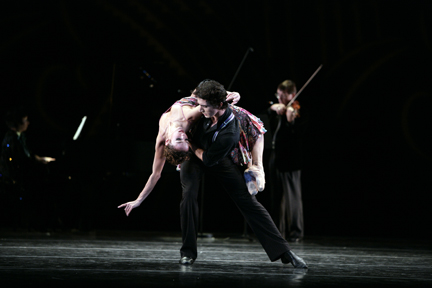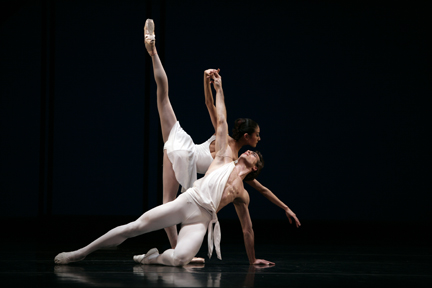O For a Muse of Fire!
Program 2: Mixed Bill
San Francisco Ballet
War memorial Opera House
San Francisco, Callifornia
February 15, 2006
by Paul Parish
copyright ©2006 by Paul Parish
 The news of this show should have been the new ballets, but in fact they were both so overshadowed by "Apollo," they'll have to take a back seat. "Apollo," as usual, opened the show.
The news of this show should have been the new ballets, but in fact they were both so overshadowed by "Apollo," they'll have to take a back seat. "Apollo," as usual, opened the show.
Helgi Tomasson's agreeable new ballet, "Blue Rose," a world premiere, is one of the slightest piano ballets he's ever made. He's set it to some ten charming rags and tangos of the Russian composer Elena Kats-Chernin, which alas slipped knotless through the mind. They were played onstage with beautiful tone and style by Natasha Feygina (assisted on some pieces by the violinist Roy Malan). Who give the effect of being the combo playing late at night on the patio of a night club in a warm climate, maybe like Napoleon House in old New Orleans. (Atmospheric lighting by Lisa J. Pinkham.) It's set for three couples, with some solos, opening and closing with everybody dancing.
When the material is this thin, the mind is free to wander over subjects like Tomasson's debt to Robbins, and to wonder just what those nicely hanging floral-printed cocktail dresses (by Judanna Lynn) were made of. The pianist's stunning black-sequined jacket merited a glance, and you were free to wonder why the dancers didn't notice the musicians. Occasionally a mood would arrest you—a dancer of temperament like Lorena Feijóo can make something happen just by refusing to let life go by, and she did. Her solo had the gestural energy of a spirited girl tired of her suitors, wanting more out of life, somehow.
Tomasson's joinery is fine, as always; the ballet just lacked imagination. The dancers' execution was splendid. The dancers were Kristin Long, Feijóo, Vanessa Zahorian, Pierre-Francois Vilanoba, Nicolas Blanc, and Joan Boada.
 "Quaternary," which was made for San Francisco Ballet by Christopher Wheeldon, had its premiere last summer when SFB was dancing outdoors at the Étés de la Danse de Paris. The piece is a fragmentary thing with some flashes of brilliance and a fair amount that's puzzling. But since it's a post-modern Four Seasons, and every season has its own composer, and timbre, and sonority, and the juxtapositions are rather shocking, it might improve upon acquaintance. I did not long to see it again, but I would like to.
"Quaternary," which was made for San Francisco Ballet by Christopher Wheeldon, had its premiere last summer when SFB was dancing outdoors at the Étés de la Danse de Paris. The piece is a fragmentary thing with some flashes of brilliance and a fair amount that's puzzling. But since it's a post-modern Four Seasons, and every season has its own composer, and timbre, and sonority, and the juxtapositions are rather shocking, it might improve upon acquaintance. I did not long to see it again, but I would like to.
Winter and Summer were the most immediately appealing, and Fall had some streaking effects—Katita Waldo's legs—that were quite exciting.
Winter (Damian Smith and Yuan-Yuan Tan) is set to parts of John Cage's "Perilous Night"; Spring (Lorena Feijóo, Tina LeBlanc, Joan Boada, and Nicolas Blanc) to music for solo cello by J.S. Bach: Summer (Muriel Maffre and Yuri Possokhov) to Arvo Part's tremulous piano music "Fur Alina," which sounds sun-drugged and hypnotic, as if the soul were moving through endless cloudless space and every plinking note could be the last; Autumn (Katita Waldo and Pierre Francois Vilanoba) to an abrasively ugly amplified noise generated by the electric guitar of Steven Mackey, who composed the music and played it.
Winter had a weird arm to it, where the shoulder somehow turned over and a long ripple undulated down through the elbow and out the fingers, and summer had rich, lazy backbends—actually the dancer was lying on the floor, rolling over, and when she'd arrive on her stomach her entire upper body would as it were levitate—Maffre managed to make this seem astonishingly intimate and satisfying.
"Apollo" was staged on SFB last year by Jacques d'Amboise (assisted by Sandra Jennings), who said that when he came here he wondered if there'd be a guy who could really dance Apollo and left thinking so well of the male corps here that ANY of them could do a good Apollo. The first cast was Gonzalo Garcia, who initiated the role last year and danced it so much like d'Amboise he actually looked like him even in the face. Last year all the Apollos were very fine but the Muses were dull.
So this year I chose to see how Sarah van Patten, who has been making every role her own for some time now and sometimes creates single-handedly the whole world of the ballet (as she did with "Romeo and Juliet"), would handle Terpsichore. She was the first I've seen here who has really danced the role.
 D'Amboise has tilted the ballet away from the ballerina. He's set the old version, with Leto giving birth, the handmaidens, and the ascent to Olympus. But he's also set the scene so that, for Terpsichore's variation, Apollo turns away from the Muse to look straight out at US. Which may be authentic, but it's always had the effect of demoralizing the ballerina (or at least seeming to). Van Patten was the first I've seen who danced as if she corresponded to the vision he was seeing—and she danced as if she were just as young as Apollo, delighting in the ideas that seemed to be pouring through her consciousness—skipping like a child, pogoing on the one foot while pawing with the other, swiveling on her pointes, diving avidly into her penchées. The whole of her dance was delicious. And the pas de deux was ravishing, as if they were American kids who'd just started the new school year and each had finally met the one, the person whose mind goes on forever and you never get tired of—as if they could finish each others' sentences. Right away there was a natural sensuousness. When she leaned on him into her first supported penchée, it was a dreamy slow descent, and as she rose out of it and upside down into the splits on his shoulders it was slow but inevitable, as if the idea just naturally evolved there on the spot and had never been done before, or even thought of.
D'Amboise has tilted the ballet away from the ballerina. He's set the old version, with Leto giving birth, the handmaidens, and the ascent to Olympus. But he's also set the scene so that, for Terpsichore's variation, Apollo turns away from the Muse to look straight out at US. Which may be authentic, but it's always had the effect of demoralizing the ballerina (or at least seeming to). Van Patten was the first I've seen who danced as if she corresponded to the vision he was seeing—and she danced as if she were just as young as Apollo, delighting in the ideas that seemed to be pouring through her consciousness—skipping like a child, pogoing on the one foot while pawing with the other, swiveling on her pointes, diving avidly into her penchées. The whole of her dance was delicious. And the pas de deux was ravishing, as if they were American kids who'd just started the new school year and each had finally met the one, the person whose mind goes on forever and you never get tired of—as if they could finish each others' sentences. Right away there was a natural sensuousness. When she leaned on him into her first supported penchée, it was a dreamy slow descent, and as she rose out of it and upside down into the splits on his shoulders it was slow but inevitable, as if the idea just naturally evolved there on the spot and had never been done before, or even thought of.
Tiit Helimets made an equally thrilling debut in the title role. He is a magnificent creature, a tall white white male with a small head and glorious proportions. His technique is very fine, but what's more remarkable is his style. In "Nutcracker," everything he did was noble and soft; but that's not his only quality. Here he was edgy, angular, subject to gusts of emotion, as new ideas or whole new faculties dawned in him.
He commands splendid plastic effects. His hands can be mesmerizing; in the eagle pose his arms really became wings, and when, in the "Summons to Olympus" he blessed the Muses' feet and then made a ring of his arms to lift them up, the gesture had a weight and grandeur to it that matched the full majesty of the music.
Elana Altman made a splendid debut as Calliope. Everyone was good; the handmaidens were Courtney Clarkson and Lily Rogers; Pauli Magierek danced the mother. Katita Waldo did everything required, and with her finger over her mouth. The orchestra played remarkably well, conducted by Martin West.
Photos, all by Erik Tomasson:
First: Vanessa Zahorian and Nicolas Blanc in "Blue Rose."
Second: The men of SFB in Wheeldon's "Quaternary."
Third: Gonzala Gomez, here with Yuan Yuan Tan, in "Apollo."
Front page: Lorena Feijoo and Pierre-Francois Villanoba in "Blue Rose."
Volume 4, No. 7
February 20, 2006
copyright
©2006 Paul Parish
www.danceviewtimes.com
|
|